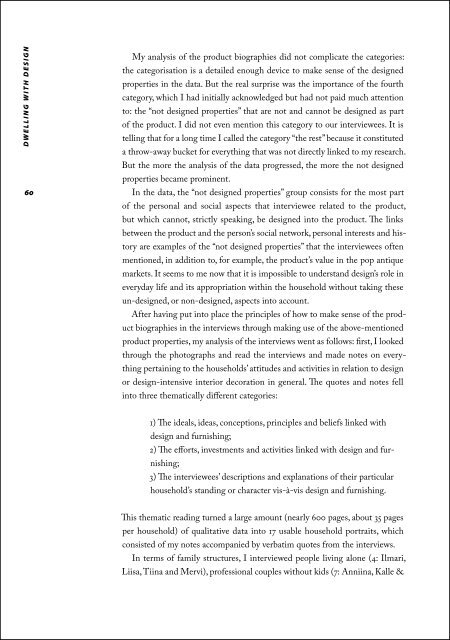Lataa ilmaiseksi
Lataa ilmaiseksi
Lataa ilmaiseksi
Create successful ePaper yourself
Turn your PDF publications into a flip-book with our unique Google optimized e-Paper software.
D W E L L I N G W I T H D E S I G N<br />
60<br />
My analysis of the product biographies did not complicate the categories:<br />
the categorisation is a detailed enough device to make sense of the designed<br />
properties in the data. But the real surprise was the importance of the fourth<br />
category, which I had initially acknowledged but had not paid much attention<br />
to: the “not designed properties” that are not and cannot be designed as part<br />
of the product. I did not even mention this category to our interviewees. It is<br />
telling that for a long time I called the category “the rest” because it constituted<br />
a throw-away bucket for everything that was not directly linked to my research.<br />
But the more the analysis of the data progressed, the more the not designed<br />
properties became prominent.<br />
In the data, the “not designed properties” group consists for the most part<br />
of the personal and social aspects that interviewee related to the product,<br />
but which cannot, strictly speaking, be designed into the product. The links<br />
between the product and the person’s social network, personal interests and history<br />
are examples of the “not designed properties” that the interviewees often<br />
mentioned, in addition to, for example, the product’s value in the pop antique<br />
markets. It seems to me now that it is impossible to understand design’s role in<br />
everyday life and its appropriation within the household without taking these<br />
un-designed, or non-designed, aspects into account.<br />
After having put into place the principles of how to make sense of the product<br />
biographies in the interviews through making use of the above-mentioned<br />
product properties, my analysis of the interviews went as follows: first, I looked<br />
through the photographs and read the interviews and made notes on everything<br />
pertaining to the households’ attitudes and activities in relation to design<br />
or design-intensive interior decoration in general. The quotes and notes fell<br />
into three thematically different categories:<br />
1) The ideals, ideas, conceptions, principles and beliefs linked with<br />
design and furnishing;<br />
2) The efforts, investments and activities linked with design and furnishing;<br />
3) The interviewees’ descriptions and explanations of their particular<br />
household’s standing or character vis-à-vis design and furnishing.<br />
This thematic reading turned a large amount (nearly 600 pages, about 35 pages<br />
per household) of qualitative data into 17 usable household portraits, which<br />
consisted of my notes accompanied by verbatim quotes from the interviews.<br />
In terms of family structures, I interviewed people living alone (4: Ilmari,<br />
Liisa, Tiina and Mervi), professional couples without kids (7: Anniina, Kalle &
















